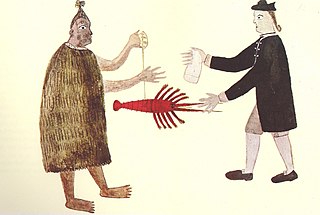
The Armed forces of the Netherlands consist of the Army, Navy, and Air Force.

The Royal Australian Air Force (RAAF), formed in March 1921, is the aerial warfare branch of the Australian Defence Force (ADF). It operates the majority of the ADF's fixed wing aircraft, although both the Australian Army and Royal Australian Navy also operate aircraft in various roles. It directly continues the traditions of the Australian Flying Corps (AFC), formed on 22 October 1912. The RAAF provides support across a spectrum of operations such as air superiority, precision strikes, intelligence, surveillance and reconnaissance, air mobility, space surveillance, and humanitarian support.

His Majesty's Armed Forces (HMAF) is the military of Tonga. It is composed of three operational components and two support elements.

The International Security Assistance Force (ISAF) was a NATO-led security mission in Afghanistan, established by the United Nations Security Council in December 2001 by Resolution 1386, as envisaged by the Bonn Agreement. Its main purpose was to train the Afghan National Security Forces (ANSF) and assist Afghanistan in rebuilding key government institutions, but was also engaged in the war with the Taliban insurgency.

The German Army is the land component of the armed forces of Germany. The present-day German Army was founded in 1955 as part of the newly formed West German Bundeswehr together with the Marine and the Luftwaffe. As of 28 February 2019, the German Army had a strength of 62,194 soldiers.

The military history of New Zealand during World War II began when New Zealand entered the Second World War by declaring war on Nazi Germany with Great Britain. The state of war with Germany was officially held to have existed since 9:30 pm on 3 September 1939, simultaneous with that of Britain, but in fact the declaration of war was not made until confirmation had been received from Britain that their ultimatum to Germany had expired. The group listened to the shortwave radio in Carl Berendsen's room in Parliament Buildings but were not certain what Neville Chamberlain had said because of static on the short-wave radio, and a coded telegraph message from London did not arrive until just before midnight as the messenger boy with the telegram in London took shelter because of a (false) air-raid warning. The Cabinet acted after hearing the Admiralty's notification to the fleet that war had broken out. The next day Cabinet approved nearly 30 war regulations as laid down in the War Book, and after completing the formalities with the Executive Council the Governor-General, Lord Galway, issued the Proclamation of War, backdated to 9.30 pm on 3 September.

The Royal Netherlands Air Force, is the military aviation branch of the Netherlands Armed Forces. It was created in 1953; its ancestor, the Luchtvaartafdeling of the Dutch Army was founded in 1913. The aerobatic display team of the Royal Netherlands Air Force is the Solo Display Team.

The Royal Netherlands Army is the land forces element of the military of the Netherlands.

The Bushmaster Protected Mobility Vehicle or Infantry Mobility Vehicle is an Australian-built four-wheel drive armoured vehicle. The Bushmaster was primarily designed by the then government-owned Australian Defence Industries (ADI), and is currently produced by Thales Australia with a support contract provided by Oshkosh Truck following the acquisition of ADI. The Bushmaster is currently in service with the Australian Army, Royal Australian Air Force, Royal Netherlands Army, British Army, Japan Ground Self Defense Force, Fiji Infantry Regiment, Jamaica Defence Force and the New Zealand Army.

Disruptive Pattern Camouflage Uniform (DPCU), also nicknamed Auscam or jelly bean camo is a five-colour military camouflage pattern used by the Australian Defence Force. It was developed and tested during the late 1970s and early 1980s.

The military history of New Zealand is an aspect of the history of New Zealand that spans several hundred years. When first settled by Māori almost a millennium ago, there was much land and resources, but war began to break out as the country's carrying capacity was approached. Initially being fought with close range weapons of wood and stone, this continued on and off until Europeans arrived, bringing with them new weapons such as muskets. Colonisation by Britain led to the New Zealand Wars in the 19th century in which settler and imperial troops and their Māori allies fought against other Māori and a handful of Pākehā. In the first half of the 20th century, New Zealanders of all races fought alongside Britain in the Boer War and both World Wars. In the second half of the century and into this century the New Zealand Defence Force has provided token assistance to the United States in several conflicts. New Zealand has also contributed troops extensively to multilateral peacekeeping operations.

Task Force Urozgan (TFU) was Australia and the Netherlands contribution to NATO's Regional Command South, International Security Assistance Force, in Afghanistan. The Dutch lead one of the four Provincial Reconstruction Teams in the southern region of the country. 1,200 to 1,400 Dutch military, mandated by the Dutch Parliament in February 2006, will attempt to maintain order in Urozgan province through July 2010. They will also attempt to develop political and economic infrastructure and to train the Afghan police.

Operation Herrick is the codename under which all British operations in the War in Afghanistan were conducted from 2002 to the end of combat operations in 2014. It consisted of the British contribution to the NATO-led International Security Assistance Force (ISAF), and support to the American-led Operation Enduring Freedom (OEF). Since 2003, Operation Herrick has increased in size and breadth to match ISAF's growing geographical intervention in Afghanistan.

Air Chief Marshal Sir Frederick Rudolph William Scherger, was a senior commander in the Royal Australian Air Force (RAAF). He served as Chief of the Air Staff, the RAAF's highest-ranking position, from 1957 until 1961, and as Chairman of the Chiefs of Staff Committee, forerunner of the role of Australia's Chief of the Defence Force, from 1961 until 1966. He was the first RAAF officer to hold the rank of air chief marshal.

Following the terrorist attacks of September 11, 2001, several nations took on Al-Qaeda and the Taliban during Operation Enduring Freedom (OEF) in Afghanistan. OEF was the initial combat operations starting on 7 October 2001, in the wake of the 11 September attacks on the United States, and during 2002 and 2003.

In January 2006, NATO's focus in southern Afghanistan was to form Provincial Reconstruction Teams with the British leading in Helmand Province and the Netherlands, Australia and Canada leading similar deployments in Orūzgān Province and Kandahar Province respectively. The United States, with 2,200 troops, stayed in control of Zabul Province. Local Taliban figures voiced opposition to the incoming force and pledged to resist it.

US and NATO International Security Assistance Force (ISAF) operations, alongside Afghan National Army forces, continued against the Taliban through 2007.

"(Is This The Way To) Amarillo" is a song written by Neil Sedaka and Howard Greenfield. It is about a man traveling to Amarillo, Texas, to find his girlfriend Marie. The song was originally to be titled "Is This the Way to Pensacola" referring to Pensacola, Florida, but Sedaka felt that Amarillo worked better than Pensacola.
The Battle of Derapet was fought near the village of Derapet in the Tangi Valley in Deh Rahwod, Orūzgān Province, southern Afghanistan, between a combined Australian Army and Afghan National Army patrol and Taliban forces on 24 August 2010. Australian forces had only recently taken over responsibility for Deh Rahwod as part of a major expansion of their area of operations which took place following the Dutch withdrawal from Afghanistan in August. The combined coalition patrol included 20 Australians and 20 Afghan National Army troops. The small Australian force from 1st Mentoring Task Force (MTF-1) based in Tarin Kowt included two sections of dismounted infantry and two ASLAV-25 guncars and was tasked with a fighting patrol to find and inflict damage on insurgent forces known to be in the area.
The No. 322 Squadron, being the oldest operational squadron of the Royal Netherlands Air Force, was founded at RAF Woodvale on 12 June 1943 as No. 322 (Dutch) Squadron with Dutch personnel under Royal Air Force control. At the end of the war 322e Jachtvliegtuig Afdeling of the Royal Netherlands Army was formed from the RAF squadron.

















